
PLASMA PHYSICS REPORTS
Scope & Guideline
Unveiling the Mysteries of Plasma and Astronomy
Introduction
Aims and Scopes
- Theoretical Plasma Physics:
Research on fundamental theories of plasma physics, including the study of instabilities, wave phenomena, and transport processes in plasmas. - Experimental Plasma Research:
Investigations that involve experimental setups to study plasma behavior, including diagnostics and measurements of plasma parameters. - Plasma Applications:
Exploration of practical applications of plasma technology in areas such as nuclear fusion, plasma processing, and environmental applications. - Numerical Simulations and Modeling:
Development and application of computational models to simulate plasma behavior under various conditions, aiding in the prediction and analysis of plasma dynamics. - Material Interactions with Plasma:
Studies focusing on the interactions between plasma and materials, including erosion, deposition, and the impact of plasma on material properties. - Dusty Plasma Physics:
Research on the behavior of dust particles in plasma environments, including their dynamics and interactions with plasma waves.
Trending and Emerging
- Advanced Tokamak Research:
There is an increasing emphasis on tokamak research, particularly in relation to reactor technologies, plasma stability, and confinement strategies for fusion energy. - Plasma Diagnostics Innovations:
Innovative diagnostic techniques, especially those involving advanced spectroscopy and imaging methods, are gaining traction as researchers seek to enhance their understanding of plasma behavior. - Plasma-Material Interactions:
Research focusing on the interactions between plasma and materials is becoming more prominent, particularly regarding erosion, deposition, and the development of plasma-facing components in fusion devices. - Applications of Cold Atmospheric Plasma:
Studies on the applications of cold atmospheric plasma in fields such as medicine and environmental science are emerging, highlighting its potential for non-thermal treatment processes. - Dusty Plasma Applications in Space Physics:
Emerging themes explore the role of dusty plasma in space environments, particularly concerning planetary atmospheres and dust dynamics in celestial bodies. - Machine Learning in Plasma Research:
The integration of machine learning techniques to analyze plasma data and optimize plasma processes is becoming increasingly relevant, reflecting broader trends in data science.
Declining or Waning
- Basic Dusty Plasma Research:
There has been a noticeable decrease in publications focusing solely on fundamental dusty plasma studies, as more research is directed towards applications and interactions of dusty plasmas in practical contexts. - Low-Temperature Plasma Studies:
Research specifically centered on low-temperature plasmas has waned, possibly due to a shift towards high-energy plasma applications and fusion-related studies. - Plasma Physics in Astrophysics:
Although astrophysical plasma studies were once a significant focus, recent trends indicate a reduced emphasis as researchers concentrate more on laboratory and fusion plasmas. - Microwave Plasma Sources:
The exploration of microwave plasma sources has diminished, likely due to the maturation of this field and a shift towards novel plasma generation techniques. - Electrohydrodynamic Phenomena:
Research specifically dedicated to electrohydrodynamic phenomena in plasma appears to be declining, possibly due to the focus on more practical applications of plasma technology.
Similar Journals
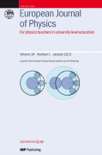
EUROPEAN JOURNAL OF PHYSICS
Fostering Dialogue in the World of PhysicsEuropean Journal of Physics, published by IOP Publishing Ltd, is a premier international journal serving the diverse field of physics and astronomy. With a commitment to advancing scientific knowledge since its inception in 1980, the journal provides a platform for original research articles, reviews, and topical discussions in various domains, including theoretical and experimental physics. Operating out of the United Kingdom, the journal has achieved a commendable Q2 ranking in the Physics and Astronomy (miscellaneous) category for 2023, reflecting its robust influence in the academic community, alongside a notable Scopus Rank that underscores its relevance in both the Social Sciences and General Physics and Astronomy fields. Although it does not currently offer open access, the journal's traditional publication model ensures rigorous peer review, maintaining high scholarly standards that are imperative for researchers, professionals, and students striving to stay ahead in their respective fields. Don't miss the opportunity to engage with cutting-edge research and contribute to the ongoing dialogue in physics by accessing this vital resource.
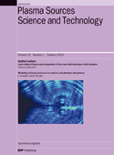
PLASMA SOURCES SCIENCE & TECHNOLOGY
Transforming Knowledge into Technological Breakthroughs in Plasma Science.PLASMA SOURCES SCIENCE & TECHNOLOGY is a premier academic journal published by IOP Publishing Ltd, focusing on the innovative field of plasma science and its applications in technology. Established in 1992, the journal has significantly contributed to advancing knowledge in this crucial area, maintaining a robust Q1 quartile ranking in Condensed Matter Physics as of 2023, which reflects its high-impact research dissemination. With an impressive Scopus ranking of 74 out of 434 in the field of Physics and Astronomy—specifically within Condensed Matter Physics—this journal stands out as a leading source for researchers and professionals dedicated to the study and application of plasma technologies. While it is not an Open Access journal, the published works are accessible through institutional subscriptions, making them available to a wide academic audience. The journal aims to provide a platform for significant contributions related to plasma physics, fostering scientific dialogue and collaboration across various disciplines. As it continues through its converged years up to 2024, PLASMA SOURCES SCIENCE & TECHNOLOGY remains essential for anyone involved in the burgeoning exploration of plasma-related scientific advancements.

Plasma
Pioneering Interdisciplinary Insights in Materials SciencePlasma is a leading open-access journal published by MDPI, devoted to the exploration and advancement of knowledge in the fields of engineering, physics, and materials science. Established in 2018, this journal provides a vital platform for researchers, professionals, and students to disseminate original findings and critical reviews related to plasma science, its applications, and its interdisciplinary aspects. With an E-ISSN of 2571-6182, Plasma actively promotes open access to ensure that research is widely accessible, reinforcing its commitment to accelerating scientific communication and collaboration across global communities. The journal enjoys respectable rankings in Scopus, with a notable position in Engineering, Physics and Astronomy, and Materials Science categories, making it an essential resource for those seeking to remain at the forefront of plasma research. Covering a range of topics until 2024, Plasma invites cutting-edge contributions that push the boundaries of understanding in this dynamic field.

PLASMA SCIENCE & TECHNOLOGY
Fostering Collaboration in Plasma Science AdvancementPLASMA SCIENCE & TECHNOLOGY is a distinguished academic journal published by IOP Publishing Ltd, focusing on the realm of condensed matter physics. With its inception in 2000 and continuing through 2024, the journal serves as a vital platform for disseminating groundbreaking research and developments in plasma science, encompassing experimental and theoretical studies that advance our understanding of plasma behavior and its applications. Although the journal is not open access, its insights are invaluable for researchers, professionals, and students devoted to the intricate physics of plasmas, particularly given its respectable Q2 quartile ranking within its category as of 2023 and a notable Scopus rank that places it within the 44th percentile among its peers. Published from the United Kingdom, the journal aims to foster collaboration and innovation in this essential field of study.
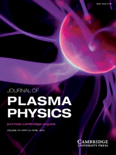
JOURNAL OF PLASMA PHYSICS
Pioneering insights in the realm of plasma physics.Welcome to the JOURNAL OF PLASMA PHYSICS, a premier publication dedicated to advancing understanding and research in the field of plasma physics. Published by Cambridge University Press, this journal has been a pivotal resource since its inception in 1967, supporting scholars and professionals engaged in the innovative exploration of plasma phenomena. With an impressive Q1 rating in Condensed Matter Physics, the journal not only holds a significant position in the academic community but also ranks within the top 50th percentile in the Scopus database. Although it currently does not offer open access, the journal provides a wealth of valuable research contributions aimed at fostering knowledge and collaboration among researchers, professionals, and students alike. The Journal of Plasma Physics is committed to publishing high-quality articles that push the boundaries of knowledge, ensuring its vital role in the ever-evolving landscape of physics research.

PHYSICS OF PLASMAS
Advancing Knowledge in Fusion and Astrophysical PlasmasPhysics of Plasmas is a premier peer-reviewed journal published by AIP Publishing, focusing on the vital and interdisciplinary field of plasma physics. With an ISSN of 1070-664X, this journal presents cutting-edge research that spans a wide array of topics including fusion energy, astrophysical plasmas, and industrial applications of plasma technologies. As a recognized leader in the field, it holds a prestigious Q1 ranking in Condensed Matter Physics, reflecting its high impact and quality of published work. The journal's scope encompasses both fundamental studies and innovative applications, serving as an essential resource for researchers, professionals, and students alike. Although it does not offer open access, its rigorous selection process ensures that only the most significant contributions are highlighted. With a convergence of expertise from 1994 to 2024, Physics of Plasmas continually shapes the future of plasma research and technology, making it a critical avenue for sharing discoveries and advancements in this dynamic area of physics.

Physics of Wave Phenomena
Advancing Knowledge in Wave PhenomenaPhysics of Wave Phenomena is an esteemed journal published by PLEIADES PUBLISHING INC, dedicated to advancing the understanding and research of wave-related phenomena across various physical contexts. Established in 2009, it has forged a reputation within the realm of Physics and Astronomy, most recently ranking in the Q3 category according to Scimago's metrics, reflecting its commitment to quality and relevance within the global scientific community. The journal's systematic exploration of wave dynamics, propagation, and interactions provides a vital platform for scholars, mathematicians, and practitioners seeking to disseminate their findings and engage with cutting-edge advancements in the field. With an evolving scope that embraces both theoretical and experimental studies, Physics of Wave Phenomena effectively serves as an essential resource for knowledge exchange, ensuring accessibility to the latest research trends, despite not currently adopting an open-access model. Indispensable to researchers and students alike, this journal plays a pivotal role in enriching the academic discourse within physics and related interdisciplinary fields.
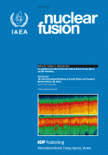
NUCLEAR FUSION
Empowering the scientific community through rigorous scholarship.NUCLEAR FUSION is a prestigious academic journal published by IOP Publishing Ltd, dedicated to advancing the field of nuclear and high-energy physics. With a significant impact factor and recognized among the top-tier journals, it boasts a Q1 ranking in both Condensed Matter Physics and Nuclear and High Energy Physics as of 2023. This journal, which has been published continuously since 1969, serves as a vital platform for researchers, professionals, and students exploring the latest advancements in fusion energy, plasma physics, and the intricate phenomena associated with high-energy states of matter. By disseminating original research, comprehensive reviews, and interdisciplinary studies, NUCLEAR FUSION strives to foster innovation and collaboration in pursuit of sustainable energy solutions, contributing significantly to the scientific community’s understanding of nuclear fusion processes. While the publication offers access options that enhance its reach, its rigorous peer-review process ensures the highest quality of scholarly communication.

EPL
Exploring New Horizons in Scientific ResearchEPL, a prominent journal published by IOP Publishing Ltd, stands at the forefront of the field of Physics and Astronomy. With a history of impactful contributions stretching from 1986 to 2024, EPL serves as a dynamic platform for researchers to disseminate their pioneering findings and innovative ideas. The journal, with a current category ranking of Q2 among its peers and a competitive Scopus rank of #101 out of 243 in the general physics and astronomy category, reflects its substantial reputation and contribution to the scientific community. Although it operates under a traditional subscription model, EPL's reach is extensive, enabling access to a diverse readership that includes academicians, industry professionals, and students alike. By fostering interdisciplinary collaboration and promoting rigorous research, EPL continues to play a vital role in shaping the future of physics and astronomy.
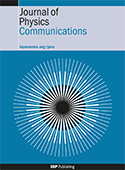
Journal of Physics Communications
Exploring New Frontiers in Physics CommunicationsJournal of Physics Communications, published by IOP Publishing Ltd, serves as a significant platform for the dissemination of innovative research in the realm of physics and astronomy. Since its inception in 2017, this Open Access journal has fostered a collaborative environment, allowing researchers, professionals, and students to share their findings and ideas without barriers. With an ISSN of 2399-6528, the journal has established its credibility in the academic community, achieving a ranking of Q3 in the 2023 category of Physics and Astronomy (miscellaneous), as well as a respectable position in Scopus with a rank of #122 out of 243 in its field. The journal's focus is on bridging theoretical concepts and practical applications, making it an essential resource for those engaged in the evolving landscape of physics. The Journal of Physics Communications not only aims to advance knowledge but also to inspire interdisciplinary collaboration, inviting contributions from diverse areas within physics. Authors and readers alike will find this journal particularly beneficial to stay updated on emerging trends and innovative research.